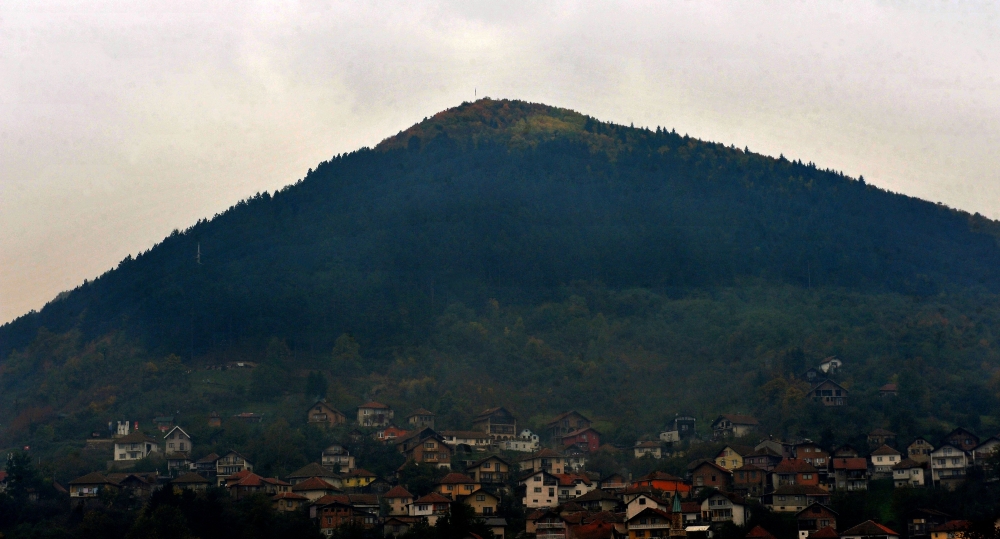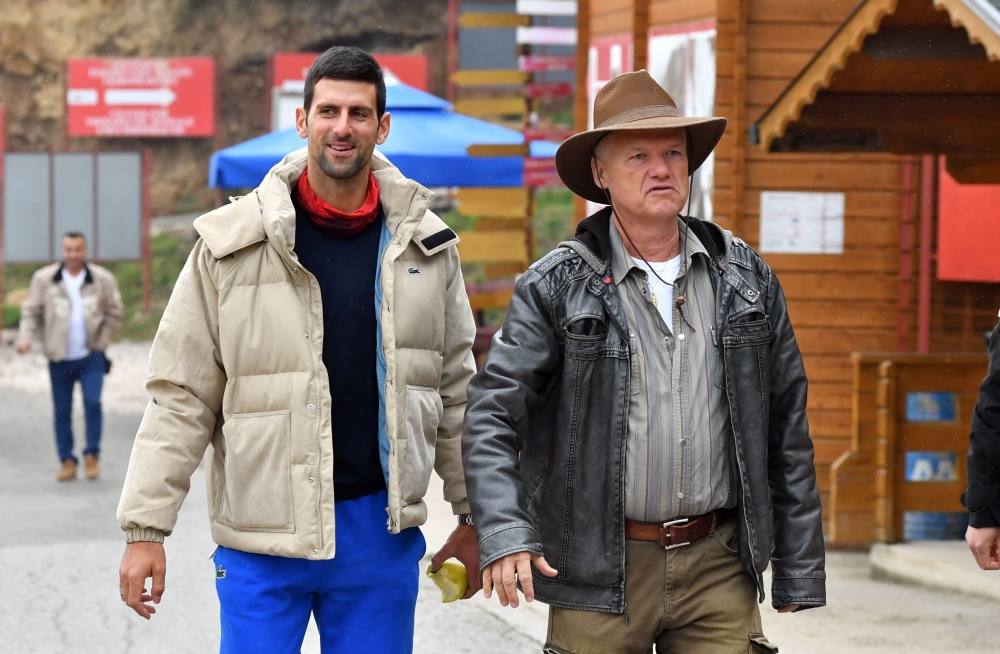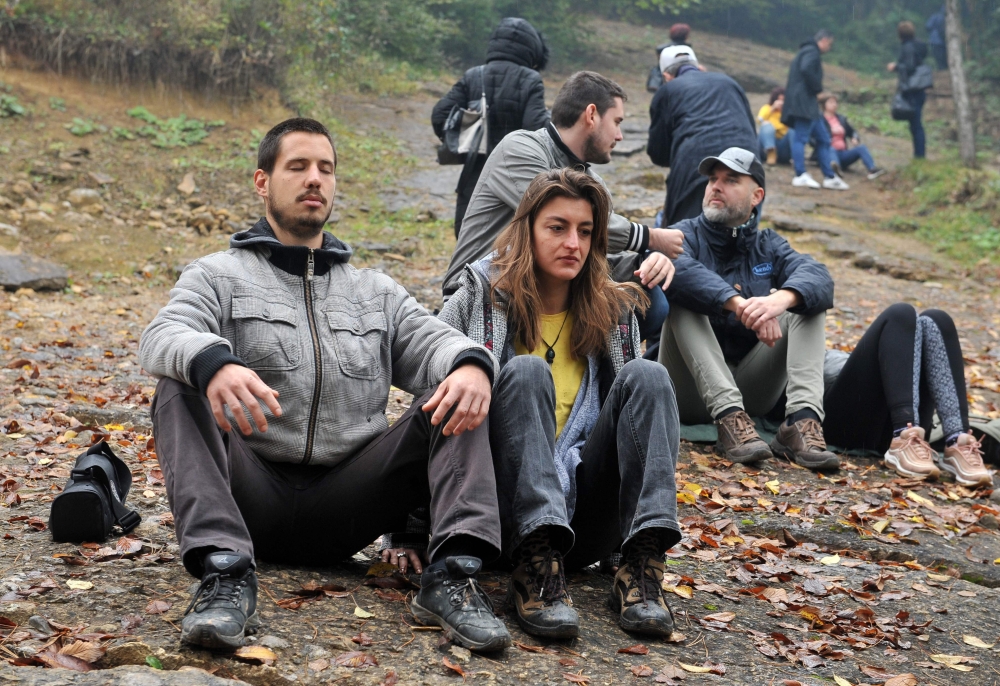
A Bosnian guide explains to tourists the tour of the so-called Bosnian Valley of Pyramids in the central-Bosnian town of Visoko, on October 24, 2020. AFP / Elvis Barukcic
Visoko, Bosnia and Herzegovina: With tree-covered slopes that rise to a pointed summit, the mountain overlooking the Bosnian town of Visoko resembles any other ordinary hillside in the Balkan state.
Yet thousands of yearly visitors -- including high-profile stars like Serbian tennis champion Novak Djokovic -- don't see it that way.
Despite scientists' efforts to debunk the claims, large numbers of people still believe the hill is part of an ancient man-made pyramid complex with healing powers.
Djokovic, who is known for his new-age spiritual interests, has made two trips this year, hailing the site as a "paradise on earth."
The mountain is now part of a controversial pyramid park founded by Semir Osmanagic, a 60-year-old self-styled explorer who "discovered" the site just outside of Sarajevo in 2005.
"I saw this hill covered with fir trees and vegetation, its slopes perfectly oriented towards the cardinal points," Osmanagic, wearing a leather jacket and Indiana Jones-style hat, told AFP on a recent weekend while leading a tour group through the site.
"It was obvious to me that it was not a natural hill but the construction" of a "technologically superior civilisation", he said, insisting it is the "largest and oldest pyramid ever built".
Archaeologists have long ago disputed this theory as pseudo-science, saying the hill is a natural geological structure.

This picture taken on October 24, 2020, shows a view of the Visocica hill, near Central-Bosnian town of Visoko. AFP / Elvis Barukcic
In a letter to Bosnian authorities in 2006, European archaeologists denounced the support given to a "cruel hoax on an unsuspecting public" that "has no place in the world of genuine science".
But this did not prevent Osmanagic, previously a US-based businessman, from carrying out "archaeological excavations" on the hill with hundreds of volunteers from abroad.
He bought a piece of surrounding land, which includes a network of tunnels he says emit a curative energy force, and a few years later opened the park through his "Bosnian Pyramid of the Sun" foundation.
Djokovic buzz
Today, the park is buzzing with visitors, who have come in even higher numbers since two recent trips from Djokovic.
In July and October, Djokovic made pilgrimages to the park and invited "all athletes" to take advantage of the healthy oxygen levels.
"I know there are many doubts and dilemmas about the authenticity (of the place)," he told AFP in October.

Tourist guide Semir Osmanagic (R) gives a tour to Serbia's tennis player Novak Djokovic at the archaeological park "Ravne", near the central-Bosnian town of Visoko, on October 15, 2020. AFP / Elvis Barukcic
But "in order to fully understand what is going on here... you have to come".
After a quiet spring subdued by the pandemic, weekend crowds are back at the park, consisting mostly of visitors from the region.
"The beginning of the season was catastrophic, but since Djokovic has been here, it's been a joy," says Nermin Alihodzic, 47, who sells tourists colourful mini-pyramids and pieces of quartz.
While the government stopped backing the park over a decade ago, local authorities have helped finance the construction of roads, parking lots and other infrastructure to encourage tourists.
A five euro ($5.94) entry fee for the whole park also includes access to the underground tunnel network which Osmanagic claims emit healing electromagnetic waves.
In his tour of the park, Osmanagic takes groups down to the chambers, urging them to hold their hands over a smooth rock and feel the "energy" rising.
Dzenana Halepovic, a 67-year-old from Sarajevo, is a frequent visitor.
In the tunnels "I feel good, I breathe well, I feel light. I simply feel like I'm receiving energy there", she said.

Tourists sit as a Bosnian guide explains the tour of the so-called Bosnian Valley of Pyramids in the central-Bosnian town of Visoko, on October 24, 2020. AFP / Elvis Barukcic
Immunity booster
For Enver Imamovic, a professor emeritus of archaeology at the University of Sarajevo, the project is pure scam.
The tunnels are likely "remnants of an ancient gold mine" while wedges of stones on the hillside, which believers consider to be the building blocks of the pyramid, are "nothing more than natural geological formations", he told AFP.
"Everything that is said about the pyramids is absolutely unacceptable".
Founder Osmanagic has also been promoting the site as a place to "boost immunity" during the coronavirus pandemic.
While he insists no cures are guaranteed, he cites other alleged miracles in which people have been healed of ailments like hypertension, diabetes or even cancer after a trip to the underground tunnels.
In a destitute country with a weak health system whose shortcomings have been exposed by the coronavirus crisis, many are drawn to the hope of alternative medicine.
Emina Kavaz, 53, says she is choosing the pyramids to treat her asthma.
"I used to come every Saturday to go through the tunnels for between 40 and 60 minutes," she told AFP.
"The price... is insignificant compared to the result obtained."




